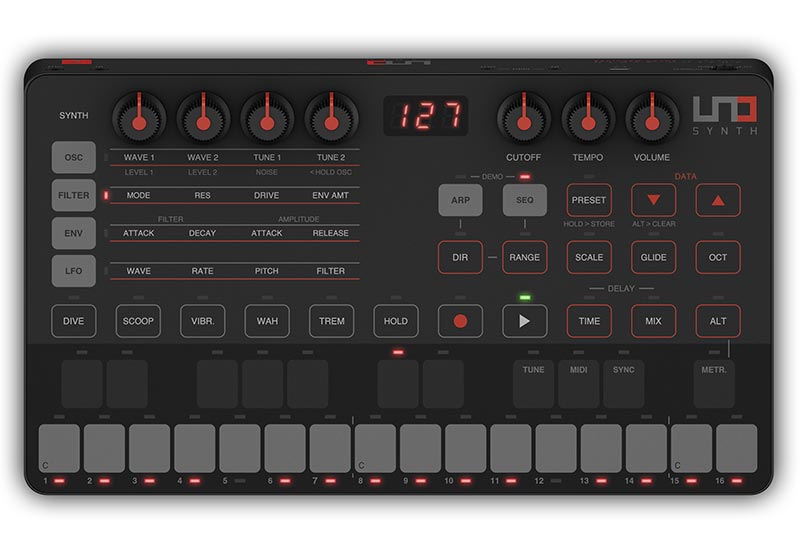IK Multimedia UNO Synth Review
Long-Term Test
Lee esta reseña en español
We put the IK Multimedia UNO Synth through a long-term test with five of our reviewers (their impressions in quotes below) and came away unimpressed. Even at $199, a very attractive price point and considering this contains analog oscillators and a solid software editor, we just don’t think “the limited” and “very cheaply made module” deserves to be in your “studio quiver” when “there are so many other excellent choices you can make beyond {the UNO’s] basic sonic palette.”
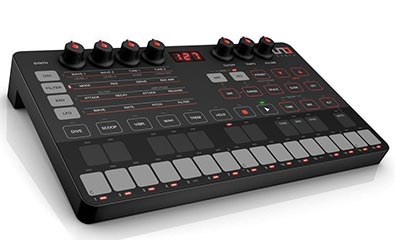
Taking into consideration the price point of the UNO, we still felt that the build quality was quite poor with ill-fitting reveals and buttons “stolen from a 1980’s home alarm system.” After just a few months of use, a crack found its way into the corner of the synth, which eventually chipped away and two of the cheap-feeling knobs lost their feel, becoming sloppy and loose. Not to mention this is one ugly unit. With a boring three-tone gray palette with red highlights, and a LED three space screen, there is absolutely nothing aesthetically pleasing here. And this, from the same country that brought the world Ferrari, Lamborghini and Ducati. Embarrassing.
All of our reviewers found the sound to be “one-dimensional” and “quickly boring.” The “UNO wants desperately to be a modern acid box, but it contains none of the essential grease and character that is required to answer that question.” There are two analog oscillators on board with a multimode 2-pole filter that allows users to get the tweaking right off the bat, but the parameters of “the chintzy knobs” are predicated on a limited matrix design that “hides much of the necessary features you want at your fingertips.” For fans of resonance, you can wring out some squelchy and ear-splitting sounds, but you can’t drive it into “self-oscillation hellfire.”
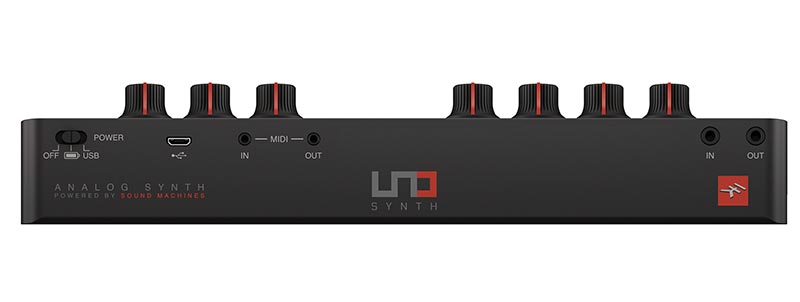
IK Multimedia UNO Synth Features:
» Two Analog Oscillators
» Monophonic
» Synthesis structure: Two VCO, Noise generator, One VCF, One VCA, Two EG, One LFO
» VCO variable shape waveforms: Triangle, Sawtooth, Pulse with variable pulse width
» VCF: 2-pole resonant multimode filter with Cutoff, Resonance, Env Amount, Drive
» LFO: Seven shapes (Sine, Triangle, Square, Saw Up, Saw Down, Random, Sample & Hold), Rate
» Modulation Destinations: Amp, Pitch, Filter, PWM, Waveshape (PWM and Waveshape via MIDI CC)
» EG: Two for Filter and Amplitude (full ADSR is available via MIDI)
» 100 Presets (20 factory non-writable, 80 user)
» 13 Selectable scales (Chromatic, Major, Minor, Major Pentatonic, Minor Pentatonic, Major Blues, Minor Blues, Harmonic Minor, Mixolydian, Dorian, Klezmer, Hungarian Gypsy, Spanish Gypsy, Japanese, South-East Asian)
» Effects: Delay, Dive, Scoop, Vibrato, Wah, Tremolo
» Ten Mode Arpeggiator with four octave range & Hold control
» Size: 25.6cm/10.1″ x 15cm/8.9″ x 4.9cm/1.93″
» Weight: 400g/14.1oz (excluded batteries)
“You may try out the Delay effect once, but you’ll never return…”
IK added a couple of sound enhancements to get more out of the sound engine, namely Drive, a “handicapped distortion effect,” and an analog delay, which can only be modified by a cumbersome process to control delay time and level. The decision to include Delay, as opposed to a different sound shaping tool, is a baffling choice since the unit only has a mono output, limiting the sound stage and expansive qualities that’s inherent in modern delays. “You may try out the Delay effect once, but you’ll never return,” one reviewer summed up.
The connectivity of the UNO is also restricted. You either power it by batteries or the USB connection, no dedicated power supply. The mono output is a 3.5mm minijack, which is not out of the question since many other budget synth are making that choice to save a few pennies, but “it’s a shame since there’s clearly room for a proper 1/4″ connection.” The unit does have an audio input to feed sounds through the UNO’s filter, but you’ll probably never do that, since you can’t control the level.
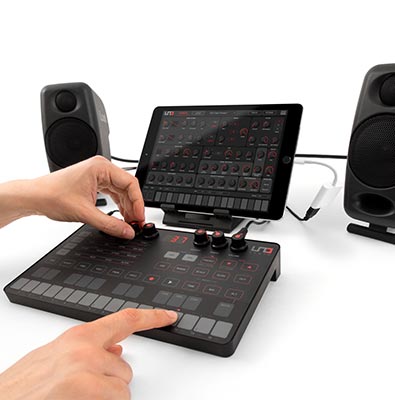
The two decent attributes of the UNO are the onboard sequencer, which is easy to use and allows you to get the proper slides and warps for that acid sound, and the software editor. Although our reviewers all found the sequencer to be intuitive, like everything else with the UNO, it’s quite restricted. For example, each pattern can only have 16 steps and you cannot chain patterns together. The software editor, in the form of a plug-in for Mac or PC, as well as an iOS app, fairs better. It opens up the UNO to new possibilities as far as sound modulation and control and is something that competitors in the crowded budget synth space do not currently offer. (Hello??! Korg? Get in touch with the MIDI Designer people and make nice…)

For a limited time only! Up to 80% off all Waves Bundles. PLUS use Waves promo code “CK901” for an additional 10%! This is Waves best deal yet! Get yours today before this special ends! GO!
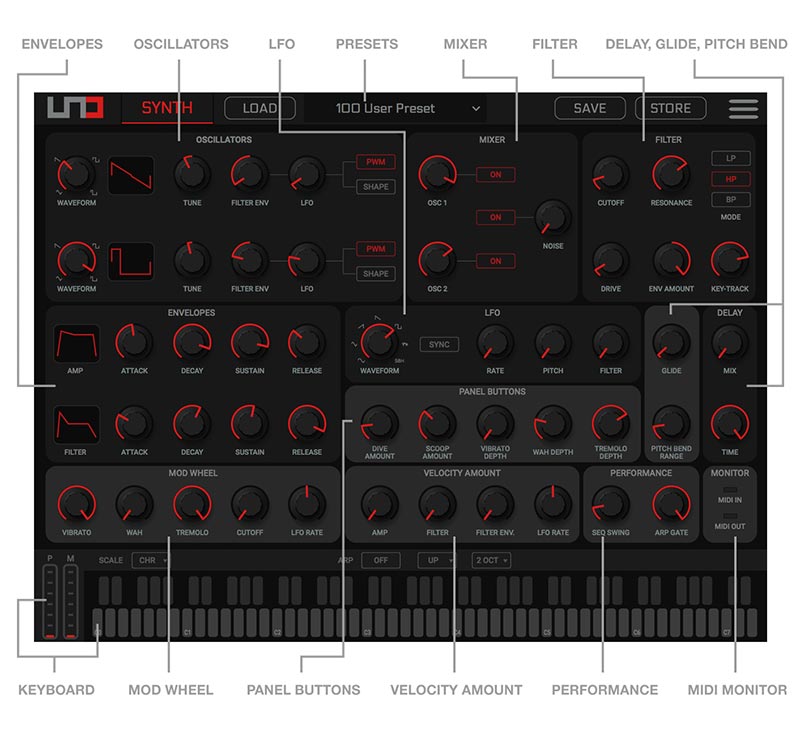
The software editor provides every parameter with its own dedicated control. In this environment, you’ll be able to push the UNO into new sonic territory. However, when pioneering this new trail, you’ll also uncover one of the UNO’s biggest shortcomings. Noise. This little box has a high-noise floor that is really accentuated when getting under the hood of the software editor. Two of our reviewers mentioned the need for a Gate to ensure “the noise doesn’t infect the rest of the mix when not in use.” Not good.
Conclusion
We salute IK for jumping into the synth hardware market, but the UNO has way too many shortcomings. You may be enticed by the analog architecture, but our reviewers found the analog oscillators “still don’t provide enough juice” compared to competing budget synths, even when you consider the software editor. With a limited sonic palette, the inability to truly shape the sound from the front panel, the noise floor, poor effects and cheap build, you should look elsewhere. Not Recommended.
Rating: 71%
Cheers:
+ Analog Oscillators
+ Software Editor
Jeers:
– Poor Build Quality
– On-Board Modulation Features
– Noisy
– Terrible Knobs For Tweaking
– Minijack output
– Uninspiring Effects
– Ugly

IK Multimedia’s UNO synth costs $199 and is available now.
Click To Tweet — Read the IK Multimedia UNO Synth Review by @Future_Music

The Future:
Not a bad start for IK’s first synth offering. There are definitely some positive takeaways with the UNO, namely the analog oscillators and the software editor. However, there are just too many shortcomings to make this a synth something that you’ll return to again and again. If there is to be a UNO Dos, IK first needs to address the poor build-quality. Beefy rubberized knobs (with dedicated functions) need to be implemented to make the UNO much more playable. The chassis needs to be reinforced in order to allow the UNO to survive a night out on the town in a user’s live rig. The Effects need to be completely rebooted to add real character and dimension to the sound. Just don’t copy what Roland did with the TB-03, dare to forge new ground – think of the famed Devilfish 303 mod or what Arturia is doing with their Brute effect. Instead of going halfway with the Arpeggiator (wasn’t even worth mentioning in the review) or the limited sequencer, push the limits. Just because its $199, doesn’t mean it has to find itself wanting in every category, especially in the aesthetic department.


